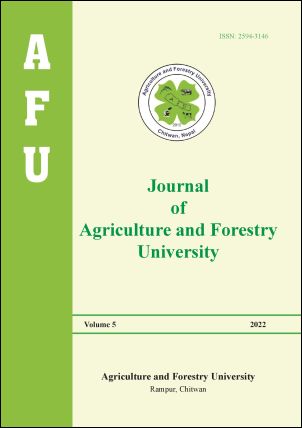Effects of varieties and fertilizer levels on yield and economics of hybrid rice at Hardinath, Nepal
DOI:
https://doi.org/10.3126/jafu.v5i1.48460Keywords:
Yield, hybrid rice, benefit cost ratioAbstract
Hybrid rice has the potential to increase rice yield. Fertilizer requirement is higher to achieve higher productivity in hybrid rice. A field experiment was carried out to evaluate the performance of hybrid rice varieties at different levels of fertilizer management. The experiment was conducted at research farm of National Rice Research Program (NRRP), Hardinath, Dhanusha, Nepal during rainy season of 2018. The experimental plot was laid out in a strip plot design with three replications. The treatment consisted of combination of six registered hybrid rice namely Arize 6444, Arize Tejgold, Gorakhnath 509, Shanti, Sudha, US 312 and two high yielding checks viz., Sabitri and Hardinath 1; and three levels of fertilizer management viz., Farmers practices ( 60-40-0 N, P2O5, k2O kg ha-1), National recommended Dose (100-30-30 N, P2O5, k2O kg ha-1) and 125% of National recommended Dose (125-40-40 N, P2O5, k2O kg ha-1). The result of research revealed that rice hybrid Sudha produced the highest grain yield (5659 kg ha-1) followed by US 312 (5153 kg ha-1). All the hybrids produced significantly higher yield than improved check varieties. The yield increment in rice hybrids ranged from 17.7 to 42.0% and 54.9 to 119.9% over Sabitri and Hardinath1 respectively. Higher gross return (Nrs 190.78 thousand ha-1), net return (Nrs 100.77 thousand ha-1) and benefit cost ratio of (2.11) was obtained in rice hybrid Sudha followed by US 312, Shanti and Arize Tejgold. Similarly, higher gross return (NRs. 178.59 thousand ha-1), net return (84.59 thousand ha-1) and benefit cost ratio (1.9) were found higher in 25% more fertilizer applied dose than National recommendation dose. Therefore, all tested hybrid rice can produce higher grain yield and 25% higher dose of fertilizer was better than national recommended dose for achieving higher yield and net income.
Downloads
Downloads
Published
How to Cite
Issue
Section
License
Copyright (c) 2022 Agriculture and Forestry University (AFU), Rampur, Chitwan, Nepal

This work is licensed under a Creative Commons Attribution-NonCommercial 4.0 International License.
This license allows reusers to distribute, remix, adapt, and build upon the material in any medium or format for noncommercial purposes only, and only so long as attribution is given to the creator.




